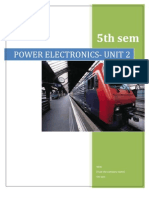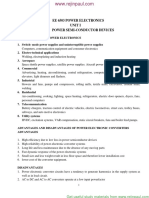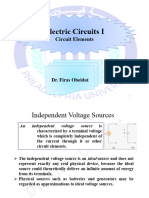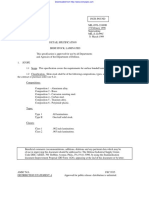Commutation Techniques 1
Uploaded by
Nataraju GandlaCommutation Techniques 1
Uploaded by
Nataraju GandlaTHE PROCESS OF TURNING ON OR OFF A
POWER ELECTRONIC DEVICE.
Commutation
Process of turning off a conducting
thyristor.
Current Commutation
Voltage Commutation
NATURAL COMMUTATION
FORCED COMMUTATION
~
T
+
v
o
v
s
R
| |
Occurs in AC
circuits
et
et
et
et
Supply voltage v
s
Sinusoidal
Voltage across SCR
Load voltage v
o
Turn off
occurs here
0
0
t
t
2t
2t
3t
3t
o
t
c
Gate Pulse
t+o
o
t+o
AC VOLTAGE CONTROLLERS.
PHASE CONTROLLED RECTIFIERS.
CYCLO CONVERTERS.
Applied to dc circuits
Commutation achieved by reverse biasing the
SCR or by reducing the SCR current below
holding current value.
Commutating elements such as inductance
and capacitance are used for commutation
purpose.
Self commutation.
Resonant pulse commutation.
Complementary commutation.
Impulse commutation.
External pulse commutation.
Load Commutation.
Line Commutation.
Elements such as inductors and capacitors
are involved.
Forced commutation is applied to DC circuits.
It is applied to choppers & inverters.
Self Commutation
Or
Load Commutation
Or
Class A Commutation
(Commutation By Resonating The Load)
Under damped condition using L,C in series
with load results in oscillating currents .
This results in turning off an SCR when the
current through load is zero.
V
R
L
V (0)
c
C
T
i
Load
+ -
In load side commutation the discharging and
recharging of capacitor takes place through
the load. Hence to test the commutation
circuit the load has to be connected.
Examples of load side commutation are
Resonant Pulse Commutation and Impulse
Commutation.
( )
( )
2
For effective commutation
the circuit should be under damped.
1
That is
2
With R = 0, and the capacitor initially uncharged
that is 0 0
sin
Note:
C
R
L LC
V
V t
i t
L
LC
e
| |
<
|
\ .
=
=
Current i
Capacitor voltage
Gate pulse
Voltage across SCR
0
t t/2
et
et
et
et
V
V
2V
Conduction time of SCR
t
e
=
V
S
V
AUX
L
C
T
1
T
3
T
2
R
L
2V
AUX
+
You might also like
- Four Quadrant Operation of DC Drives: - Dual Converters100% (1)Four Quadrant Operation of DC Drives: - Dual Converters12 pages
- EE1301-Power Electronics: Short Questions and AnswersNo ratings yetEE1301-Power Electronics: Short Questions and Answers15 pages
- STEM: Science, Technology, Engineering and Maths Principles Teachers Pack V10From EverandSTEM: Science, Technology, Engineering and Maths Principles Teachers Pack V10No ratings yet
- Methods of Improving Transient StabilityNo ratings yetMethods of Improving Transient Stability2 pages
- Single Phase Transformer Construction and WorkingNo ratings yetSingle Phase Transformer Construction and Working11 pages
- Lecture 1-Electrical Elements - Series & Parallel Circuits.No ratings yetLecture 1-Electrical Elements - Series & Parallel Circuits.49 pages
- Faculty Lecture Notes On (Wheatstone Bridge)No ratings yetFaculty Lecture Notes On (Wheatstone Bridge)8 pages
- Power Factor Meters - Electrodynamometer Type Power Factor Meter0% (1)Power Factor Meters - Electrodynamometer Type Power Factor Meter4 pages
- 05-Nonpilot OC Protection of Transmission LinesNo ratings yet05-Nonpilot OC Protection of Transmission Lines23 pages
- Transmission Line Network in Himachal PradeshNo ratings yetTransmission Line Network in Himachal Pradesh13 pages
- Aim: To Prepare The Connection of Sodium Vapour and Metal Halide Lamps and Measure Their Efficacies. ObjectiveNo ratings yetAim: To Prepare The Connection of Sodium Vapour and Metal Halide Lamps and Measure Their Efficacies. Objective8 pages
- Transformer Transformer: Unit ObjectiveNo ratings yetTransformer Transformer: Unit Objective56 pages
- High Voltage Engineering: Unit-I Electric Field StressesNo ratings yetHigh Voltage Engineering: Unit-I Electric Field Stresses9 pages
- Circuit Theory - Lecture Notes, Study Material and Important Questions, AnswersNo ratings yetCircuit Theory - Lecture Notes, Study Material and Important Questions, Answers5 pages
- Experiment 4 - Three Phase Uncontrolled RectifierNo ratings yetExperiment 4 - Three Phase Uncontrolled Rectifier13 pages
- Prof. Ch. SAI BABU: Online Gate Coaching Classes100% (1)Prof. Ch. SAI BABU: Online Gate Coaching Classes103 pages
- Questions On Phase Conversion & Tap Changing TransformersNo ratings yetQuestions On Phase Conversion & Tap Changing Transformers18 pages
- Unit-Iii Electric Heating: Part-A 1. What Are The Advantages of Electric Heating?No ratings yetUnit-Iii Electric Heating: Part-A 1. What Are The Advantages of Electric Heating?13 pages
- Voltage Multipliers: Half-Wave Voltage Doubler100% (1)Voltage Multipliers: Half-Wave Voltage Doubler5 pages
- Thevenins & Nortons Theorem and Maximum Power Transfer Theorem PDFNo ratings yetThevenins & Nortons Theorem and Maximum Power Transfer Theorem PDF13 pages
- Simulation of Some Power System, Control System and Power Electronics Case Studies Using Matlab and PowerWorld SimulatorFrom EverandSimulation of Some Power System, Control System and Power Electronics Case Studies Using Matlab and PowerWorld SimulatorNo ratings yet
- Job Safety Environmental Analysis Pre-Task BriefingNo ratings yetJob Safety Environmental Analysis Pre-Task Briefing5 pages
- Competitive Strategy Within Engineering Management (2533)No ratings yetCompetitive Strategy Within Engineering Management (2533)7 pages
- Akash Karia - TED Talks Storytelling - 23 Storytelling Techniques From The Best TED Talks-CreateSpace Independent Publishing Platform (2015)No ratings yetAkash Karia - TED Talks Storytelling - 23 Storytelling Techniques From The Best TED Talks-CreateSpace Independent Publishing Platform (2015)40 pages
- Lecture 3 - Pressure of Concrete On FormworkNo ratings yetLecture 3 - Pressure of Concrete On Formwork49 pages
- Alarm List of Waukesha Generator Protection System BE1-IPS100No ratings yetAlarm List of Waukesha Generator Protection System BE1-IPS1001 page
- Topics To Be Covered: Binary Digital Modulation M-Ary Digital Modulation Comparison StudyNo ratings yetTopics To Be Covered: Binary Digital Modulation M-Ary Digital Modulation Comparison Study26 pages
- ESD - CS6 - Small Scale Embedded System Design ExampleNo ratings yetESD - CS6 - Small Scale Embedded System Design Example54 pages
- (Ebook) Linear Feedback Control: Analysis and Design with MATLAB (Advances in Design and Control) by Dingyu Xue, YangQuan Chen, Derek P. Atherton ISBN 9780898716382, 0898716381 - The full ebook with all chapters is available for download100% (1)(Ebook) Linear Feedback Control: Analysis and Design with MATLAB (Advances in Design and Control) by Dingyu Xue, YangQuan Chen, Derek P. Atherton ISBN 9780898716382, 0898716381 - The full ebook with all chapters is available for download59 pages
- Lag, Lead, Lead-Lag - Compensation in Control System100% (2)Lag, Lead, Lead-Lag - Compensation in Control System11 pages
- A fully digital approach to replicate peri-implant soft tissue contours and emergence profile in the esthetic zoneNo ratings yetA fully digital approach to replicate peri-implant soft tissue contours and emergence profile in the esthetic zone5 pages
- Method Acting Reconsidered Theory Practice Future 1st Ed 978 0 312 22309 0978 1 349 62271 9No ratings yetMethod Acting Reconsidered Theory Practice Future 1st Ed 978 0 312 22309 0978 1 349 62271 9302 pages
- Four Quadrant Operation of DC Drives: - Dual ConvertersFour Quadrant Operation of DC Drives: - Dual Converters
- EE1301-Power Electronics: Short Questions and AnswersEE1301-Power Electronics: Short Questions and Answers
- STEM: Science, Technology, Engineering and Maths Principles Teachers Pack V10From EverandSTEM: Science, Technology, Engineering and Maths Principles Teachers Pack V10
- Lecture 1-Electrical Elements - Series & Parallel Circuits.Lecture 1-Electrical Elements - Series & Parallel Circuits.
- Power Factor Meters - Electrodynamometer Type Power Factor MeterPower Factor Meters - Electrodynamometer Type Power Factor Meter
- Aim: To Prepare The Connection of Sodium Vapour and Metal Halide Lamps and Measure Their Efficacies. ObjectiveAim: To Prepare The Connection of Sodium Vapour and Metal Halide Lamps and Measure Their Efficacies. Objective
- High Voltage Engineering: Unit-I Electric Field StressesHigh Voltage Engineering: Unit-I Electric Field Stresses
- Circuit Theory - Lecture Notes, Study Material and Important Questions, AnswersCircuit Theory - Lecture Notes, Study Material and Important Questions, Answers
- Questions On Phase Conversion & Tap Changing TransformersQuestions On Phase Conversion & Tap Changing Transformers
- Unit-Iii Electric Heating: Part-A 1. What Are The Advantages of Electric Heating?Unit-Iii Electric Heating: Part-A 1. What Are The Advantages of Electric Heating?
- Thevenins & Nortons Theorem and Maximum Power Transfer Theorem PDFThevenins & Nortons Theorem and Maximum Power Transfer Theorem PDF
- Power System Wide-area Stability Analysis and ControlFrom EverandPower System Wide-area Stability Analysis and Control
- Simulation of Some Power System, Control System and Power Electronics Case Studies Using Matlab and PowerWorld SimulatorFrom EverandSimulation of Some Power System, Control System and Power Electronics Case Studies Using Matlab and PowerWorld Simulator
- Job Safety Environmental Analysis Pre-Task BriefingJob Safety Environmental Analysis Pre-Task Briefing
- Competitive Strategy Within Engineering Management (2533)Competitive Strategy Within Engineering Management (2533)
- Akash Karia - TED Talks Storytelling - 23 Storytelling Techniques From The Best TED Talks-CreateSpace Independent Publishing Platform (2015)Akash Karia - TED Talks Storytelling - 23 Storytelling Techniques From The Best TED Talks-CreateSpace Independent Publishing Platform (2015)
- Alarm List of Waukesha Generator Protection System BE1-IPS100Alarm List of Waukesha Generator Protection System BE1-IPS100
- Topics To Be Covered: Binary Digital Modulation M-Ary Digital Modulation Comparison StudyTopics To Be Covered: Binary Digital Modulation M-Ary Digital Modulation Comparison Study
- ESD - CS6 - Small Scale Embedded System Design ExampleESD - CS6 - Small Scale Embedded System Design Example
- (Ebook) Linear Feedback Control: Analysis and Design with MATLAB (Advances in Design and Control) by Dingyu Xue, YangQuan Chen, Derek P. Atherton ISBN 9780898716382, 0898716381 - The full ebook with all chapters is available for download(Ebook) Linear Feedback Control: Analysis and Design with MATLAB (Advances in Design and Control) by Dingyu Xue, YangQuan Chen, Derek P. Atherton ISBN 9780898716382, 0898716381 - The full ebook with all chapters is available for download
- Lag, Lead, Lead-Lag - Compensation in Control SystemLag, Lead, Lead-Lag - Compensation in Control System
- A fully digital approach to replicate peri-implant soft tissue contours and emergence profile in the esthetic zoneA fully digital approach to replicate peri-implant soft tissue contours and emergence profile in the esthetic zone
- Method Acting Reconsidered Theory Practice Future 1st Ed 978 0 312 22309 0978 1 349 62271 9Method Acting Reconsidered Theory Practice Future 1st Ed 978 0 312 22309 0978 1 349 62271 9

























































































